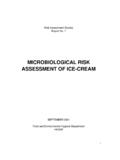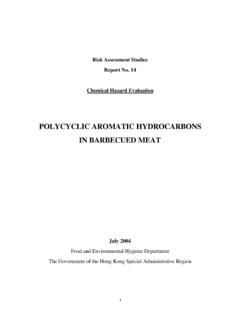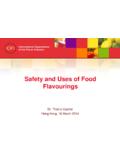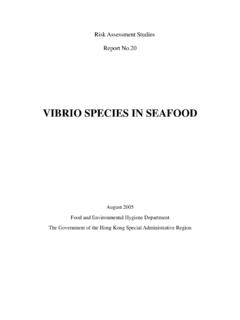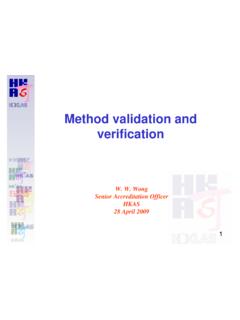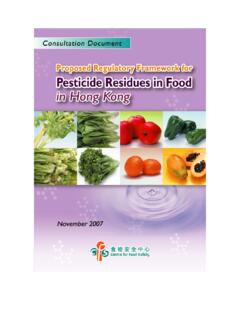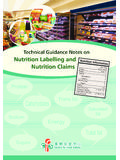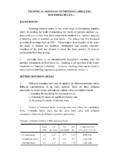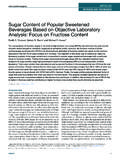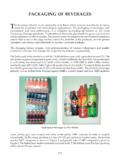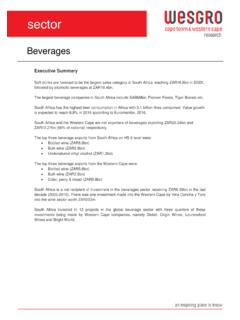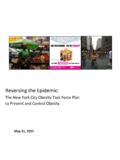Transcription of RISK ASSESSMENT ON ARTIFICIAL SWEETENERS …
1 Risk ASSESSMENT Studies Report No. 15. Chemical Hazard Evaluation RISK ASSESSMENT ON. ARTIFICIAL SWEETENERS . IN BEVERAGES. November 2003. Food and Environmental Hygiene Department HKSAR. i This is a publication of the Food and Public Health Branch of the Food and Environmental Hygiene Department of HKSAR. Government. Under no circumstances should the research data contained herein be reproduced, reviewed, or abstracted in part or in whole, or in conjunction with other publications or research work unless a written permission is obtained from the Department.
2 Acknowledgement is required if other parts of this publication are used. Correspondence: Risk ASSESSMENT Section Food and Environmental Hygiene Department 43/F, Queensway Government Offices, 66 Queensway, Hong Kong. Email: ii Table of Contents: Page Abstract 2. Objective 3. Introduction 3. Scope of Study 5. Methodology 7. Consumption Data Sampling Plan Laboratory Analysis Dietary Exposures to ARTIFICIAL SWEETENERS from Beverages Results 10. beverage Consumption Data Concentration of ARTIFICIAL SWEETENERS in Beverages Dietary Exposures to ARTIFICIAL SWEETENERS from Beverages Discussion 13.
3 Conclusion and Recommendations 17. Advice to Trade Advice to Consumers References 19. Annex I: Summary Information on ARTIFICIAL SWEETENERS 21. Annex II: Distributions of ARTIFICIAL SWEETENERS in Beverages 22. iii Risk ASSESSMENT Studies Report No. 15. RISK ASSESSMENT ON. ARTIFICIAL SWEETENERS . IN BEVERAGES. 1. Abstract This study estimated the exposures to ARTIFICIAL SWEETENERS from beverages by secondary school students in Hong Kong and assessed the effects on their health. Five ARTIFICIAL SWEETENERS including acesulfame potassium, aspartame, cyclamic acid, saccharin and sucralose were studied.
4 ARTIFICIAL SWEETENERS are substances which are substantially sweeter than the common carbohydrate SWEETENERS such as sucrose. Their sweetness potencies range from about 30 times to several thousand times that of sucrose. They provide little or no caloric value to the normal diet and they do not affect insulin or glucose levels. Hence, they may assist in weight management and provide sweet-tasting foods for people with diabetes. The exposures to the studied ARTIFICIAL SWEETENERS from beverages by secondary school students in Hong Kong were estimated by using the local consumption data and the concentrations of ARTIFICIAL SWEETENERS in beverage samples taken from the local market.
5 Results showed that the daily exposures to the studied ARTIFICIAL SWEETENERS were all within their respective Acceptable Daily Intakes (ADIs). for both average and high consumers. The exposures ranged from of the ADI for saccharin to of the ADI for acesulfame potassium for average consumers, and from of the ADI for saccharin to of the ADI for acesulfame potassium for high consumers. Based on this finding, it could be concluded that exposures to the ARTIFICIAL SWEETENERS including acesulfame potassium, aspartame, cyclamic acid, saccharin and sucralose from beverages do not pose a health risk to secondary school students in Hong Kong in both average and high consumers.
6 2. Risk ASSESSMENT on ARTIFICIAL SWEETENERS in Beverages OBJECTIVE. The aims of this study are (i) to estimate the dietary exposures to ARTIFICIAL SWEETENERS by the secondary school students in Hong Kong and (ii). assess the health effects of ARTIFICIAL SWEETENERS resulting from these exposures. INTRODUCTION. 2. The use of ARTIFICIAL SWEETENERS in food industry has been growing rapidly in recent years. Whereas in the past they were chiefly used in diabetic products, they have become more popular as alternative SWEETENERS in many food products especially in soft drinks and other beverages, as consumers aim to eat less sugar.
7 Thus, the Food and Environmental Hygiene Department (FEHD) initiated this study to estimate the dietary exposures to ARTIFICIAL SWEETENERS by secondary school students in Hong Kong and assess the health effects of ARTIFICIAL SWEETENERS to secondary school students. 3. ARTIFICIAL SWEETENERS are generally considered as those substances which on a weight basis are substantially sweeter than the common 3. carbohydrate SWEETENERS such as sucrose. Their sweetness intensities range 1. from about 30 times to several thousand times that of sucrose. Accordingly, they can be used at much lower concentrations in 4.
8 ARTIFICIAL SWEETENERS are also called non-nutritive SWEETENERS as they contribute little or no caloric value to the normal diet. For example, saccharin has no caloric value while aspartame produces 4 3. 5. ARTIFICIAL SWEETENERS have become more popular and their use has been expanding for many years. They are now common ingredients in a wide range of foods and beverages including soft drinks, candies, chewing gum, desserts like pudding, gelatin, and ice cream. In addition, several ARTIFICIAL SWEETENERS are available for use as table-top SWEETENERS , which consumers add directly to coffee, tea, fruits, breakfast cereal, 6.
9 ARTIFICIAL SWEETENERS can deliver an equivalent sweetness value to sugar at a lower cost and can offer consumers a way to enjoy the taste of sweetness with little or no energy intake. 5 Hence, they may assist in weight management. They may also be used to provide sweet-tasting foods and beverages for people who have to restrict carbohydrate intake, such as people with diabetes as they do not affect insulin or glucose 4. 7. As with all food additives, ARTIFICIAL SWEETENERS have been assessed for their safety before they are permitted for use in foods.
10 The Joint Food and Agriculture Organization/ World Health Organization Expert Committee on Food Additives (JECFA) evaluated the safety of ARTIFICIAL 4. SWEETENERS based on toxicological data obtained from animal and/or human studies. An Acceptable Daily Intake (ADI) would be allocated according to the safety evaluation. 8. An ADI is the amount of a food additive, expressed on a body weight basis that can be ingested daily over a lifetime without appreciable health risk. 6 Animal tests are normally used to determine the maximum dietary level of an additive which demonstrates no toxic effects, the no-observed-effect-level or NOEL and the most sensitive animal species are used.
